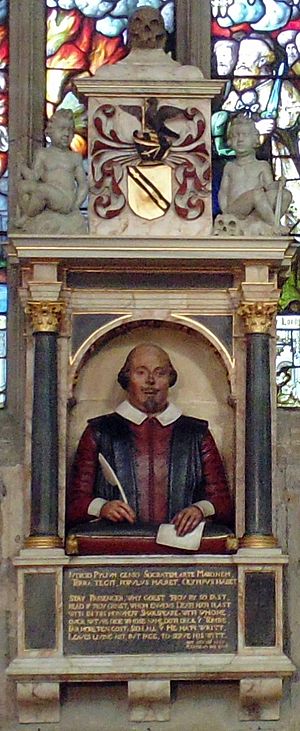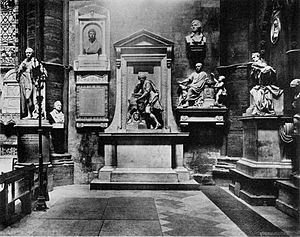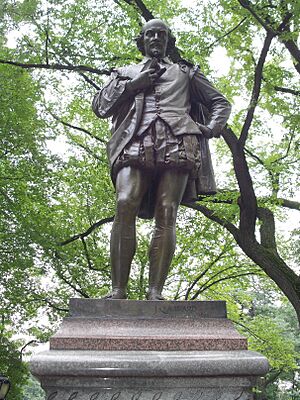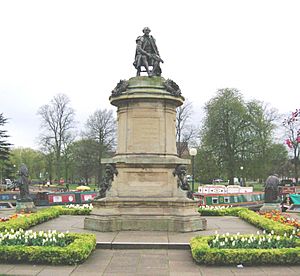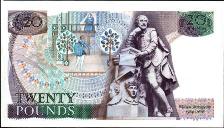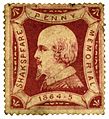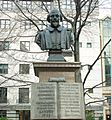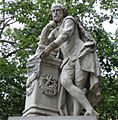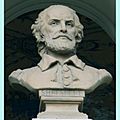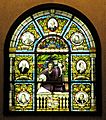Memorials to William Shakespeare facts for kids
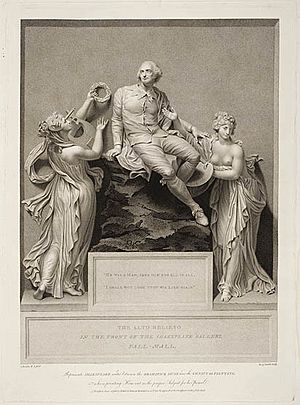
William Shakespeare, a famous playwright, has many statues and memorials around the world. These tributes celebrate his life and works. Some important ones include his tomb in Stratford-upon-Avon (around 1623), a statue in Poets' Corner in Westminster Abbey, London (1740), and a statue in New York's Central Park (1872).
Contents
Early Memorials: The 17th Century
The very first memorial to Shakespeare is his tomb, called a funerary monument. It is inside Holy Trinity Church in Stratford-upon-Avon, Warwickshire, UK. This is the same church where he was baptized as a baby. We don't know the exact date it was built. However, it must have been between Shakespeare's death in 1616 and 1623. It is mentioned in the First Folio, a collection of his plays published in 1623.
The monument was made by Gerard Johnson. It is on a wall above Shakespeare's grave. It shows a bust (a sculpture of his head and shoulders) of the poet. He holds a quill pen in one hand and paper in the other. His arms rest on a cushion. Above him is the Shakespeare family's coat of arms. On each side are two figures. One represents hard work and holds a spade. The other represents rest and holds a torch and a skull.
Growing Fame: The 18th Century
As Shakespeare became more famous, memorials started appearing in important national places. William Kent designed a statue for Poets' Corner in Westminster Abbey. The sculptor Peter Scheemakers created it, and it was put in place in 1740. People like Lord Burlington and Alexander Pope helped pay for it. The Shakespeare Ladies Club held special events to raise money. They had benefit performances of Julius Caesar and Hamlet.
The statue's base has carved heads. These likely show Queen Elizabeth I, Henry V, and Richard III. Shakespeare is shown leaning on books. He points to a scroll with a quote from The Tempest. It talks about the world disappearing without a trace. A similar statue was put in a Glasgow theater in 1764. It is now in the Theatre Royal in Dunlop Street.
In 1757, the English actor David Garrick ordered a marble statue of Shakespeare. It was made by the French sculptor Louis-François Roubiliac. Garrick placed it in his Temple to Shakespeare at Hampton. People think Garrick himself posed for the statue. In 1779, it was given to the British Museum. In 2005, it moved to the British Library. Garrick also asked Roubiliac to make a bust of Shakespeare. This was for his Shakespeare festival in Stratford in 1769. It is now in the Garrick Club in London.
In 1788, a sculpture by Thomas Banks was placed on the outside wall of John Boydell's Boydell Shakespeare Gallery. It was called Shakespeare attended by Painting and Poetry. The sculpture showed Shakespeare resting against a rock. He was between the Muse of Drama and the Spirit of Painting. Below it was a quote from Hamlet: "He was a Man, take him for all in all, I shall not look upon his like again". The building was later torn down. The sculpture was then moved to the garden of New Place in Stratford.
Worldwide Recognition: The 19th Century
By the 1800s, Shakespeare's fame was huge. People even called it "bardolatry," meaning great admiration for the bard. Statues and memorials started appearing outside Britain. In Britain, Shakespeare's place as the national poet became even stronger.
Shakespeare in the United States
New York City's Central Park has a Shakespeare statue. It was ordered in 1864 to celebrate 300 years since Shakespeare's birth in 1564. Money was raised by a play, Julius Caesar. Edwin Booth played the main role, and John Wilkes Booth played Mark Antony. John Quincy Adams Ward designed the statue. In 1873, the statue was moved to a special area called the Mall. A copy of the statue was made in 1986. It is in the State Theater in Montgomery, Alabama, which has a yearly Shakespeare Festival.
In 1888, a large seated statue by William Ordway Partridge was revealed in Lincoln Park, Chicago. In 1896, a bronze statue by Frederick William MacMonnies was put up. It was part of a series of statues of world geniuses. This one is in the reading-room gallery of the Library of Congress.
British Memorials
After Banks's sculpture moved to New Place in 1871, London had no outdoor public memorial to Shakespeare. The new New York statue in 1872 made this absence very noticeable. In 1874, a rich man named Baron Albert Grant wanted to fix this. He put a fountain with a marble Shakespeare statue in Leicester Square gardens. Giovanni Fontana sculpted it. It was a copy of Scheemakers's statue in Poets' Corner. Another statue was put up in Stratford, London, a suburb with the same name as Shakespeare's hometown.
In 1877, a group in Stratford-upon-Avon decided to build a Shakespeare memorial. It included a theater building. This was on land next to the River Avon, near the church where Shakespeare was buried. A statue was also made in 1888 by Lord Ronald Gower. It is in Stratford's Bancroft Gardens. The monument shows Shakespeare sitting on a pedestal. Around him, on the ground, are statues of Hamlet, Lady Macbeth, Prince Hal, and Falstaff. These characters show Shakespeare's amazing creativity. They represent Philosophy, Tragedy, History, and Comedy. Another statue is in a special spot on the outside of the town hall building.
Tributes in Other Countries
Most memorials are in English-speaking countries. However, there are also monuments elsewhere. In 1888, a statue designed by Paul Fournier was put up on the Boulevard Haussmann in Paris, France.
Modern Tributes: The 20th Century
British Tributes
From 1970 to 1993, an image of Shakespeare's Poets' Corner statue was on the back of the £20 notes. Next to the statue was a picture of the balcony scene from Romeo and Juliet.
A detailed memorial to Shakespeare was created in Southwark Cathedral. This was his local church when he lived in London, near the Globe Theatre. Shakespeare's brother Edmund is buried there, along with other actors and playwrights from his time. A reclining statue of Shakespeare, made by Henry McCarthy in 1912, was placed in a special area. This area had carvings of Elizabethan Southwark, showing the Globe, Winchester Palace, and the church tower. A beautiful stained glass window was also made, showing Shakespearean characters. The first window was destroyed by a bomb in World War II. It was replaced in 1954. A birthday celebration for Shakespeare is held there every April.
European Tributes
Germany played an early role in appreciating Shakespeare. But a statue wasn't put up in Weimar until 1904. It shows him "seated and staring into the distance with a bemused and thoughtful look." Otto Lessing designed it.
In Denmark, a memorial statue was ordered to celebrate 300 years since Hamlet was published in 1603. The statue, designed by Louis Hasselriis, was paid for by public donations. It was put up in Elsinore, along with a sculpture of Hamlet.
Australian Tributes
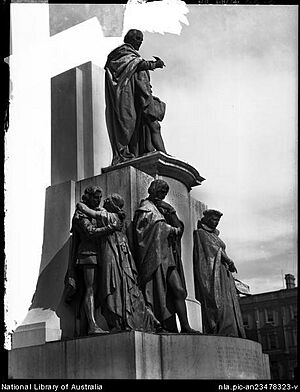
A memorial in Sydney, Australia, was put up in 1926. Australian sculptor Sir Bertram MacKennal designed it. Henry Gullett, a former president of the Shakespeare Society of New South Wales, ordered it. His daughter, Lucy Gullett, made sure the statue was built after her father passed away. It shows Shakespeare at the top. Around the base are five of his most famous characters: Hamlet, Romeo and Juliet embracing, Portia, and Falstaff. It is in Shakespeare Place, between the Mitchell Library and the Royal Botanic Gardens. In 1959, the statue was moved for the Cahill Expressway.
A project to create a Shakespeare statue in Ballarat started in 1889. However, it wasn't finished until 1960. Money problems caused many delays. Finally, private donations provided enough money. They hired Andor Meszaros, an Australian artist from Hungary, to make a bronze sculpture. The statue shows Shakespeare bowing, as if at the end of a play.
North American Tributes
A statue was made for Logan Circle, Philadelphia in 1926. Alexander Stirling Calder designed it. It doesn't show Shakespeare himself. Instead, it shows Touchstone the jester from As You Like It, representing comedy. It also shows Hamlet, representing tragedy. Touchstone is lounging and laughing. His feet hang over the tall stone base. His left arm rests on Hamlet's legs. Hamlet is seated and thinking deeply. His knife hangs over Touchstone's body. The first lines of the famous "All the world's a stage" speech from As You Like It are carved on the base.
A statue made from tin was put up in the gardens outside the Festival Theatre. This is the main theater for the Stratford Shakespeare Festival. The festival happens every year from April to November in Stratford, Ontario, Canada.
Images for kids
-
A bust of Shakespeare in the St Mary Aldermanbury Garden, London (though depicting Shakespeare, this is actually a memorial to John Heminge and Henry Condell, editors of the First Folio).
-
This bust is placed on the city gate of Verona, with lines from Romeo and Juliet stating "there is no world without Verona walls..."
-
Bust of Shakespeare on the National Theatre building, Hviezdoslav Square, Bratislava.
-
Stained glass at Ottawa Public Library features Charles Dickens, Archibald Lampman, Duncan Campbell Scott, Lord Byron, Alfred, Lord Tennyson, William Shakespeare, Thomas Moore


